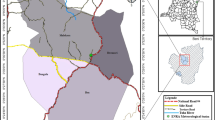Abstract
This paper compares two previously established meteorological modelling methods when determining areas in Western Australia (WA) where conditions are favourable for infection of wheat (Triticum aestivum) by Tilletia indica, the cause of Karnal bunt. There was a strong correlation (r = 0.83) between the Humid Thermal Index (HTI) model, which used long-term, average-monthly data, and the rainfall model, which was based on the per cent chance of at least three Suitable Rain Events (SRE) during the susceptible period (August to October). Results suggest that northern wheat growing areas are too hot and dry (HTI < 2.2, chance of SRE 15–27%), southern areas are marginal to too cold and/or wet (HTI > 3, chance of SRE 68–97%), eastern areas are marginal to too hot and dry (HTI around 2.2, chance of SRE 24–50%), and western areas are suitable (HTI between 2.2 and 3.3, chance of SRE 41–78%). The between and within year analysis indicated that infection was more likely to occur if anthesis occurred in northern areas in August, in October in southern areas, in September in eastern areas, and in August, September, and October in western and south-eastern areas. Model results suggest that data on HTI and SRE within each year may be more accurate in determining climatic suitability for Karnal bunt in WA, compared to long-term, average data. In the event that T. indica does successfully enter WA, it may be possible to limit spread of Karnal bunt through carefully planned sowing schedules.
Similar content being viewed by others
References
Aujla SS, Sharma YR, Chand K, Sawney SS (1977) Influence of weather factors on the incidence and epidemiology of karnal bunt disease of wheat in the Punjab. Indian Journal of Ecology 4, 71–74.
Aujla SS, Sharma I, Gill KS (1990) Effect of soil moisture and temperature on teliospore germination of Nevossia indica. Indian Phytopathology 43, 223–225.
Beattie BR, Biggerstaff DR (1999) A wimp of a disease … but an irresistible political opportunity. Choices Second Quarter, 4–8.
Bonde MR, Peterson GL, Schaad NW, Smilanick JL (1997) Karnal bunt of wheat. Plant Disease 81, 1370–1377.
Brennan JP, Warham EJ, Byerlee D, Hernandez-Estrada J (1992) Evaluating the economic impact of quality reducing, seed-borne diseases: lessons from Karnal bunt of wheat. Agricultural Economics 6, 345–352.
Crous PW, Van Jaarsveld AB, Castlebury LA, Carris LM, Frederick RD, Pretorius ZA (2001) Karnal bunt of wheat newly reported from the African continent. Plant Disease 85, 561.
Duran R (1972) Further aspects of teliospore germination in North American smut fungi. Canadian Journal of Botany 50, 2569–2573.
Fuentes-Davila G (1996) Karnal bunt. In ‘Bunt and smut diseases of wheat: concepts and methods of disease management’. (Eds RD Wilcoxson, EE Saari) pp. 26–32. (CIMMYT: Mexico, D.F.)
Goates B (1988) Histology of infection of wheat by Tilletia indica, the Karnal bunt pathogen. Phytopathology 78, 1434–1441.
Holmes GJ, Jackson LF, Perring TM (1996) Imperial Valley conditions limit Karnal bunt in wheat. California Agriculture May–June, 29–33.
Jhorar OP, Mavi HS, Sharma I, Mahi GS, Mathauda SS, Singh G (1992) A biometeorological model for forecasting Karnal bunt disease of wheat. Plant Disease Research 7, 204–209.
Mavi HS, Jhorar OP, Sharma I, Singh G, Mahi GS, Mathauda SS, Aujla SS (1992) Forecasting Karnal bunt disease of wheat — a meteorological method. Cereal Research Communications 20, 67–74.
Mitra M (1931) Tilletia indica n. sp. A new bunt of wheat in India. Annals of Applied Biology 18, 178–180.
Murray GM, Brennan JP (1998) The risk to Australia from Tilletia indica, the cause of Karnal bunt of wheat. Australasian Plant Pathology 27, 212–225.
Nagarajan S, Aujla SS, Nanda GS, Sharma I, Goel LB, Kumar J, Singh DV (1997) Karnal bunt (Tilletia indica) of wheat — a review. Review of Plant Pathology 76, 1207–1214.
Randall PJ, Moss HJ (1990) Some effects of temperature regime during grain filling on wheat quality. Australian Journal of Agricultural Research 41, 603–617.
Sansford C (1998) Karnal bunt (Tilletia indica): detection of Tilletia indica Mitra in the US: potential risk to the UK and the EU. In ‘Bunts and smuts of wheat: an international symposium’. North Carolina, 17–20 August 1997’. (Eds VS Malik, DE Mathre) pp. 273–302. (NAPPO: Ottawa)
Sing A, Prasad R (1978) Date of sowing and meteorological factors in relation to occurrence of Karnal bunt of wheat in U.P. Tarai. Indian Journal of Mycology and Plant Pathology 8, 2.
Smilanick JL, Hoffmann JA, Royer MH (1985) Effect of temperature, pH, light and desiccation on teliospore germination of Tilletia indica. Phytopathology 75, 1428–1431.
Smilanick JL, Prescott JM, Hoffman JA, Secrest LR, Weise K (1989) Environmental effects on survival and growth of secondary sporidia and teliospores of Tilletia indica. Crop Protection 8, 86–90.
Smiley RW (1997) Risk assessment for Karnal bunt occurrence in the Pacific Northwest. Plant Disease 81, 689–692.
Smith OP, Peterson GL, Beck RJ, Schaad NW, Bonde MR (1996) Development of a PCR-based method for identification of Tilletia indica, causal agent of Karnal bunt of wheat. Phytopathology 86, 115–122.
Stansbury CD, Pretorius SA (2001) Kenners waarsku: Karnalbrand kan ook elders in SA voorkom. Landbou weekblad 1207, 26–27.
Warhman EJ, Flores D (1988) Farmer surveys on the relation of agronomic practices to Karnal bunt disease of wheat in the Yaqui Valley, Mexico. Tropical Pest Management 34, 373–381.
Author information
Authors and Affiliations
Corresponding author
Rights and permissions
About this article
Cite this article
Stansbury, C.D., McKirdy, S.J. Forecasting climate suitability for Karnal bunt of wheat: a comparison of two meteorological methods. Australasian Plant Pathology 31, 81–92 (2002). https://doi.org/10.1071/AP01080
Received:
Accepted:
Issue Date:
DOI: https://doi.org/10.1071/AP01080




